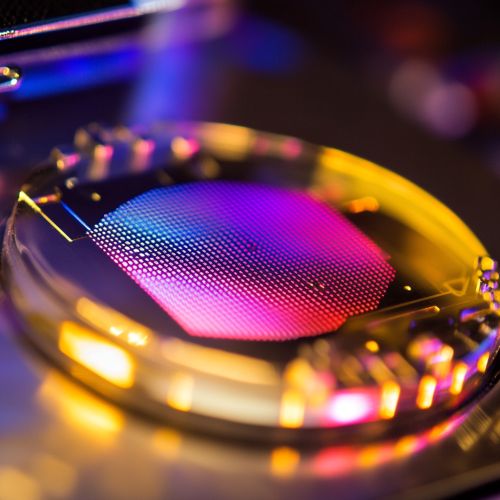Quantum Dot Transistors: Difference between revisions
(Created page with "== Introduction == Quantum dot transistors are a class of electronic devices that utilize quantum dots as the active component in their operation. These transistors are a subset of nanoelectronics, which is a field that explores the use of nanometer-scale materials and structures to create electronic devices with enhanced or novel properties. Quantum dot transistors have garnered significant interest due to their potential applications in quantum computing,...") |
No edit summary |
||
| Line 7: | Line 7: | ||
Quantum dots are nanoscale semiconductor particles that exhibit quantum mechanical properties. They are typically composed of semiconductor materials such as [[cadmium selenide]] (CdSe), [[indium arsenide]] (InAs), or [[lead sulfide]] (PbS). The unique feature of quantum dots is their size-dependent electronic and optical properties, which arise from the quantum confinement effect. This effect occurs when the size of the quantum dot is comparable to the [[de Broglie wavelength]] of the charge carriers, leading to discrete energy levels. | Quantum dots are nanoscale semiconductor particles that exhibit quantum mechanical properties. They are typically composed of semiconductor materials such as [[cadmium selenide]] (CdSe), [[indium arsenide]] (InAs), or [[lead sulfide]] (PbS). The unique feature of quantum dots is their size-dependent electronic and optical properties, which arise from the quantum confinement effect. This effect occurs when the size of the quantum dot is comparable to the [[de Broglie wavelength]] of the charge carriers, leading to discrete energy levels. | ||
[[Image:Detail-98493.jpg|thumb|center|Close-up of a quantum dot transistor on a silicon wafer.|class=only_on_mobile]] | |||
[[Image:Detail-98494.jpg|thumb|center|Close-up of a quantum dot transistor on a silicon wafer.|class=only_on_desktop]] | |||
== Structure and Operation of Quantum Dot Transistors == | == Structure and Operation of Quantum Dot Transistors == | ||
Latest revision as of 01:17, 18 October 2024
Introduction
Quantum dot transistors are a class of electronic devices that utilize quantum dots as the active component in their operation. These transistors are a subset of nanoelectronics, which is a field that explores the use of nanometer-scale materials and structures to create electronic devices with enhanced or novel properties. Quantum dot transistors have garnered significant interest due to their potential applications in quantum computing, optoelectronics, and high-performance computing.
Quantum Dots: A Brief Overview
Quantum dots are nanoscale semiconductor particles that exhibit quantum mechanical properties. They are typically composed of semiconductor materials such as cadmium selenide (CdSe), indium arsenide (InAs), or lead sulfide (PbS). The unique feature of quantum dots is their size-dependent electronic and optical properties, which arise from the quantum confinement effect. This effect occurs when the size of the quantum dot is comparable to the de Broglie wavelength of the charge carriers, leading to discrete energy levels.


Structure and Operation of Quantum Dot Transistors
Quantum dot transistors are typically structured similarly to conventional field-effect transistors (FETs), with the key difference being the incorporation of quantum dots in the channel region. The basic components of a quantum dot transistor include the source, drain, gate, and the channel, which contains the quantum dots.
Channel and Quantum Dots
The channel of a quantum dot transistor is embedded with quantum dots, which act as discrete charge islands. These quantum dots can be arranged in a single layer or multiple layers, depending on the desired electronic properties. The quantum dots in the channel can be synthesized using various methods, including colloidal synthesis, molecular beam epitaxy, and chemical vapor deposition.
Charge Transport Mechanism
The charge transport in quantum dot transistors is governed by the tunneling of electrons between adjacent quantum dots. This tunneling process is influenced by the Coulomb blockade effect, which occurs due to the quantization of charge and the small capacitance of the quantum dots. The Coulomb blockade effect results in the suppression of electron flow at low bias voltages, leading to distinct current-voltage characteristics.
Fabrication Techniques
The fabrication of quantum dot transistors involves several advanced techniques to ensure precise control over the size, distribution, and density of quantum dots in the channel. Some of the key fabrication techniques include:
Colloidal Synthesis
Colloidal synthesis is a solution-based method that allows for the production of quantum dots with controlled size and composition. This technique involves the chemical reaction of precursors in a solvent, followed by the growth of quantum dots through nucleation and growth processes. Colloidal quantum dots can be deposited onto substrates using techniques such as spin coating, dip coating, or inkjet printing.
Molecular Beam Epitaxy
Molecular beam epitaxy (MBE) is a vacuum-based technique that enables the growth of high-quality quantum dots on semiconductor substrates. In MBE, atomic beams of the constituent elements are directed onto a heated substrate, where they condense to form quantum dots. This method allows for precise control over the size, shape, and composition of the quantum dots.
Chemical Vapor Deposition
Chemical vapor deposition (CVD) is another technique used to fabricate quantum dots. In CVD, gaseous precursors are introduced into a reaction chamber, where they decompose and react on the substrate surface to form quantum dots. CVD offers the advantage of scalability and compatibility with various substrate materials.
Applications of Quantum Dot Transistors
Quantum dot transistors have a wide range of potential applications due to their unique electronic properties. Some of the key applications include:
Quantum Computing
Quantum dot transistors are considered promising candidates for quantum bits (qubits) in quantum computing. The discrete energy levels of quantum dots enable the manipulation of quantum states, which is essential for quantum computation. Quantum dot-based qubits offer advantages such as scalability, long coherence times, and compatibility with existing semiconductor technologies.
Optoelectronics
In optoelectronics, quantum dot transistors can be used to develop advanced photodetectors, light-emitting devices, and solar cells. The tunable optical properties of quantum dots allow for the design of devices with specific wavelength sensitivities and efficiencies. Quantum dot transistors can also be integrated into photonic circuits for applications in optical communication and sensing.
High-Performance Computing
Quantum dot transistors have the potential to enhance the performance of conventional computing systems by enabling faster and more efficient electronic devices. The unique charge transport properties of quantum dot transistors can lead to reduced power consumption and increased processing speeds, making them suitable for high-performance computing applications.
Challenges and Future Directions
Despite the promising potential of quantum dot transistors, several challenges remain in their development and commercialization. These challenges include:
Scalability and Integration
One of the major challenges in the development of quantum dot transistors is the scalability and integration of quantum dots into existing semiconductor manufacturing processes. Ensuring uniformity and reproducibility of quantum dot arrays on a large scale is critical for the practical implementation of these devices.
Stability and Reliability
The stability and reliability of quantum dot transistors are also important considerations. Quantum dots are susceptible to environmental factors such as temperature, humidity, and oxidation, which can affect their electronic properties. Developing robust encapsulation and passivation techniques is essential to enhance the stability and longevity of quantum dot transistors.
Cost and Manufacturing Complexity
The cost and complexity of manufacturing quantum dot transistors pose significant challenges to their widespread adoption. Advanced fabrication techniques such as MBE and CVD are expensive and require specialized equipment, which can limit the scalability of quantum dot transistor production.
